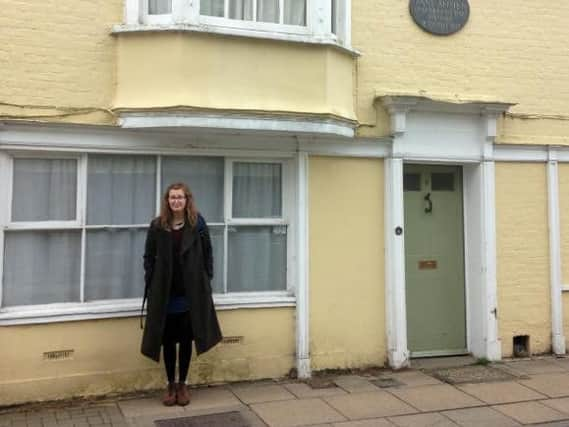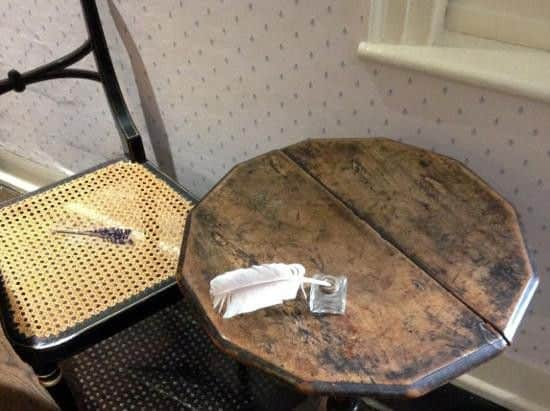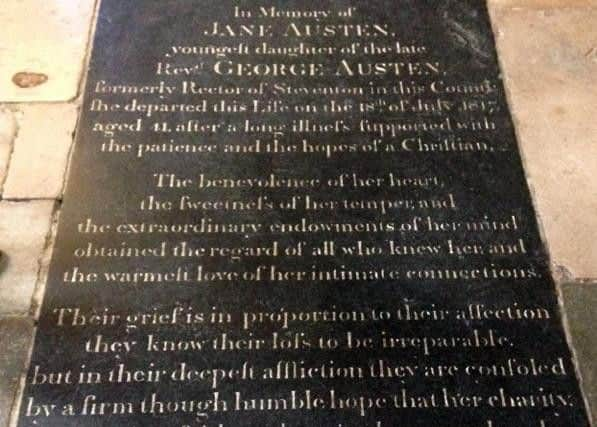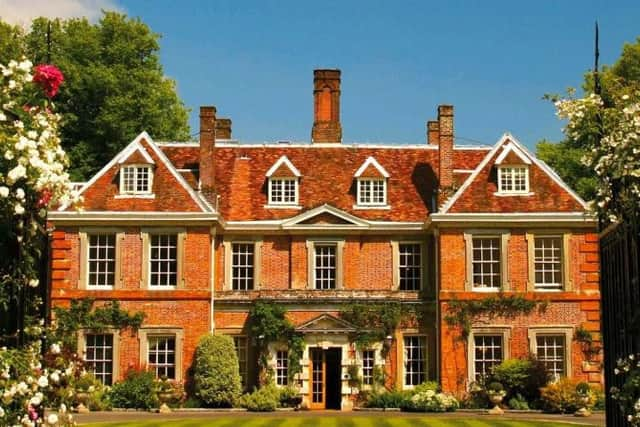Travel: Book a novel weekend break


Church warden, Linton, who is white-haired and stooped with age, but robust and animated with it, has taken care of the small village's place of worship since 1993 – and in the process, the Austen family legacy here.
He pulls a circular piece of metal from a nook in the stone wall and hands it to me.
Advertisement
Hide AdAdvertisement
Hide AdLike traditional skates, but without the sharp slip of blade for carving through ice, he explains there's no knowing whether Jane used this particular pattern to keep her feet dry, "but there's certainly a chance".


This is the church where Jane's father, George Austen, was rector, from her birth in 1775, until the family moved to Bath in 1800, when Jane's brother James took it on.
Simple and compact, with a sharp taupe steeple puncturing the grey, wintry sky, it's a plain, stocky building. Inside is quiet, the cool air percolating with a sense of history.
I am visiting Jane's home county of Hampshire as 2017 marks the 200th anniversary of her death from suspected Addison's disease, in 1817, aged just 41.
Advertisement
Hide AdAdvertisement
Hide AdSt Nicholas' is something of a pilgrimage site for Austen fans around the world.


The church and grounds are open to visitors, and there are regular services people can attend, too.
Linton shows me an entry in the parish marriage registry that contains Jane's scrawl, where she'd jokily inserted herself.
"Jane got hold of it when she was a teenager for a lark," he says, adding, with a chuckle: "What her father thought of it is not on record!"
Advertisement
Hide AdAdvertisement
Hide AdHe speaks of the Austens with such affection and good humour, it's almost as if he knew them personally, even wryly quoting Jane's witticisms on the 'big' family who dominated the village during her childhood (she was not a fan).


Author of Pride and Prejudice, Sense and Sensibility, Mansfield Park, Persuasion, Northanger Abbey, and Linton's favourite, Emma, Jane's body of work is, frankly, one of the most searing, amusing and nuanced in existence.
She queried – bitingly and drolly – the role of women, religion, marriage and wealth, in ways that no one before her had attempted, and no one since has surpassed.
While in Steventon, all that's left of the rectory where Jane grew up is the church, a towering elm, a twisty lime tree and a gate, there is more of her to be found in nearby Chawton.
Advertisement
Hide AdAdvertisement
Hide AdA wide, red brick house squats on the corner of the village, eave windows peeping from beneath raised eyebrows of roof tiles, at a tea room across the street, glass all fogged up by cakes baking and steaming mugs of tea.


The house was bestowed upon Jane, her mother, her sister and family friend, Martha Lloyd, in 1809, by Jane's brother Edward, who owned it as part of his far grander estate close-by, Chawton House.
Now home to the Jane Austen's House Museum, the nook of a cottage has a curvy garden crammed with fragrant herbs and bitter plants that would have been used in tinctures and homemade medicines, while inside you can find trinkets and replicas of the Austen household's belongings, including a turquoise and gold ring of Jane's.
The cottage is where Jane did the bulk of her writing, so finding yourself stood in front of the tiny, teetering walnut desk and chair where Lizzie Bennett, Anne Elliot and Emma came into being is actually quite emotional.
Advertisement
Hide AdAdvertisement
Hide AdThe desk itself is so small – barely large enough to prop a notebook and an elbow – that it's hard to imagine Jane hunched over it, her brain unspooling stories that would weave themselves into the fabric of our literary and cultural history.
Her gravestone then, in the floor of the vaulted Winchester Cathedral, scuffed by generations of visitors' feet until it gleams blackly, knocks you out with its simplicity.
It's quite a slab, but it doesn't say what she did, or who she really was. Instead, her male relatives decided to highlight her "charity, devotion, faith and purity" in the inscription.


Historians wrangle over this omission, one that's arguably a deception and a disservice.
Advertisement
Hide AdAdvertisement
Hide AdDid they do it because they were both proud of Jane's writing - hence the expense of laying her to rest in Winchester Cathedral - but also conflicted? After all, an unmarried woman supporting herself through novel writing was not exactly the 'done' thing. Best instead to mention "the extraordinary endowments of her mind" without noting just how progressive and profound her mind and ideas really were.
Of course, the cathedral now has a permanent exhibition detailing Jane's achievements, and features a series of illustrated boards that share biographical notes and snippets on her novels.
The problem is, for someone who changed so drastically the way we think about the novel, there is comparatively little known about Jane, and many of her private letters that could shed more light are still guarded closely by her descendents.
The truth is, the only place you'll ever really find Jane, is in her books.
JANE AUSTEN 200 - EVENT HIGHLIGHTS
Advertisement
Hide AdAdvertisement
Hide Ad1. The Mysterious Miss Austen, The Gallery, Winchester Discovery Centre
May 13-July 24 – See the only item of clothing that can certifiably be traced back to Jane – a scallop edge, brown patterned pelisse coat. The Mysterious Miss Austen exhibition will also feature portraiture, letters and first edition copies of Jane's novels. Free entry. Visit hampshireculturaltrust.org.uk/the-gallery-at-winchester-discovery-centre
2. Jane Austen Tour And Tea, Winchester Cathedral
First Saturday of the month, Feb-April and June-November –
Pop along to Winchester Cathedral (usual admission £7.95), firstly to see Jane's tombstone and secondly, because on selected dates throughout the year, it will be hosting Austen related tours - cuppa and cake in the refectory afterwards included! Explore the cathedral itself and learn about Jane's relationship with it, before seeing her final home on nearby College Street. Tours are £12.50. Visit www.winchester-cathedral.org.uk
3. Sitting With Jane, various locations in Basingstoke
June to September – Follow a trail to find 25 specially designed 'Book Benches' inspired by Jane and her stories. Visit www.sittingwithjane.com for full details.
4. Northanger Abbey, The Haymarket, Basingstoke
Advertisement
Hide AdAdvertisement
Hide AdMarch 8-11: The only surviving English Regency theatre is staging a production of Northanger Abbey, Jane's satire of Gothic novels, published after her death. Tickets £19-£24. Visit anvilarts.org.uk
5. Rethinking Sanditon, Chawton House Library, Chawton
March 11: Over tea and cake, discuss Jane's unfinished manuscript, known as Sanditon, with Dr Anne Toner, Professor Michael Biddiss and Dr Sarah Comyn. Tickets £18.50. Visit www.chawtonhouse.org
TRAVEL FACTS
Ella Walker from the Press Association was a guest of VisitHampshire (www.visit-hampshire.co.uk)
Doubles at Lainston House Hotel (www.exclusive.co.uk/lainston-house; 01962 776088) from £175 with breakfast.
Advertisement
Hide AdAdvertisement
Hide AdDetails of events and exhibitions scheduled for Jane Austen 200: A life in Hampshire can be found at janeausten200.co.uk
For more information on the Jane Austen House Museum, visit www.jane-austens-house-museum.org.uk